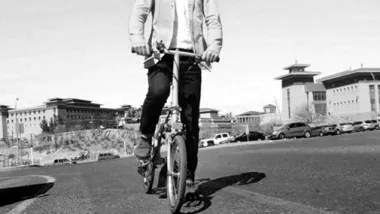This morning I was reading through my daily dose of planning related blogs and dropped in on The Overhead Wire, Jeff Wood's excellent transit soapbox. One of Jeff's most recent posts links to an October 25th Reuters article announcing China's $272 billion dollar investment in new rail infrastructure. Yes, you read that correctly. 272 billion. Can't you see president Hu Jintao bringing his pinky to his lips, à la Dr. Evil?
This morning I was reading through my daily dose of planning related blogs and dropped in on The Overhead Wire, Jeff Wood's excellent transit soapbox. One of Jeff's most recent posts links to an October 25th Reuters article announcing China's $272 billion dollar investment in new rail infrastructure. Yes, you read that correctly. 272 billion. Can't you see president Hu Jintao bringing his pinky to his lips, à la Dr. Evil?
Meanwhile, our main stream media, and by extension much of America, seem distracted by political non-issues like Sarah Palin's wardrobe to give sufficient coverage to this incredible piece of news.
Should this not be a serious kick in the pants ?! A call to arms? I can see it now, millions of new t-shirts minted at Urban Outfitters that say "Rails not Wars" printed over a fashionably faded American flag. Faux hipsters will buy them by the millions with proceeds going to, well, rails and not wars. I digress.
Reconnecting America often refers to American cities' relatively recent rush to fund transit projects of all kinds with an inadequate pool of federal support money as the Transit Space Race.
Jeff's aforementioned blog post places the race in a more global context:
I don't know about you all, but I can't even imagine a scenario where
we pump that much money into freight and passenger rail lines because
our politics would get in the way. That is almost double the demand
that exists in the United States for new transit lines and certainly an
investment like that in the United States would be an enormous benefit
for our future ancestors. Are we going to see the light? Or fall
further behind?
China is clearly investing intelligently in their own 21st century, one where building something tangible and long-lasting like rail will produce more sustainable econonic growth for rural and urban areas alike.
America on the other hand is clinging to economic bailout straws. According to many experts such a measure does not
guarantee a lasting economic recovery, nor will it produce something as basic
and beneficial as a modern passenger and freight rail network that should contribute to the
transit rich towns and cites we will need as the 21st century
progresses. Meanwhile, a nationwide infrastructure crisis continues to deepen and an economic recession grows.
Jim Kunstler often says, we have become a very unserious nation, one that is far too used to getting something for nothing. I don't think there is a better way to describe the psychological roots of the Wall-Street mortgage meltdown.
We have fallen asleep at the wheel and China's recent investment should serve as our wake-up call.
After all, we can't win a race if we choose not to compete in the first place.

Planetizen Federal Action Tracker
A weekly monitor of how Trump’s orders and actions are impacting planners and planning in America.

Chicago’s Ghost Rails
Just beneath the surface of the modern city lie the remnants of its expansive early 20th-century streetcar system.

Amtrak Cutting Jobs, Funding to High-Speed Rail
The agency plans to cut 10 percent of its workforce and has confirmed it will not fund new high-speed rail projects.

Ohio Forces Data Centers to Prepay for Power
Utilities are calling on states to hold data center operators responsible for new energy demands to prevent leaving consumers on the hook for their bills.

MARTA CEO Steps Down Amid Citizenship Concerns
MARTA’s board announced Thursday that its chief, who is from Canada, is resigning due to questions about his immigration status.

Silicon Valley ‘Bike Superhighway’ Awarded $14M State Grant
A Caltrans grant brings the 10-mile Central Bikeway project connecting Santa Clara and East San Jose closer to fruition.
Urban Design for Planners 1: Software Tools
This six-course series explores essential urban design concepts using open source software and equips planners with the tools they need to participate fully in the urban design process.
Planning for Universal Design
Learn the tools for implementing Universal Design in planning regulations.
Caltrans
City of Fort Worth
Mpact (founded as Rail~Volution)
City of Camden Redevelopment Agency
City of Astoria
City of Portland
City of Laramie






























